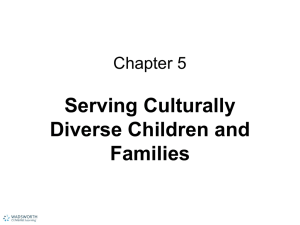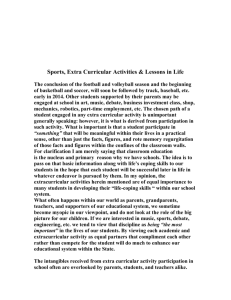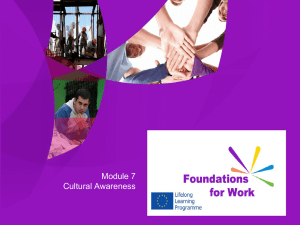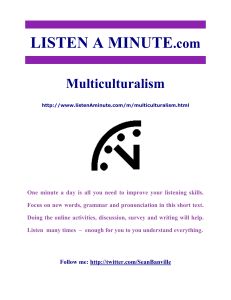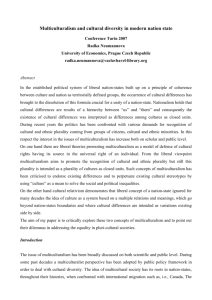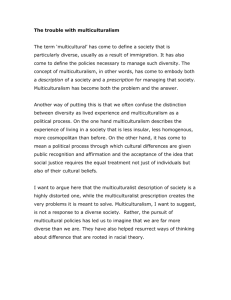The General Education Curriculum in US Colleges and Universities
advertisement
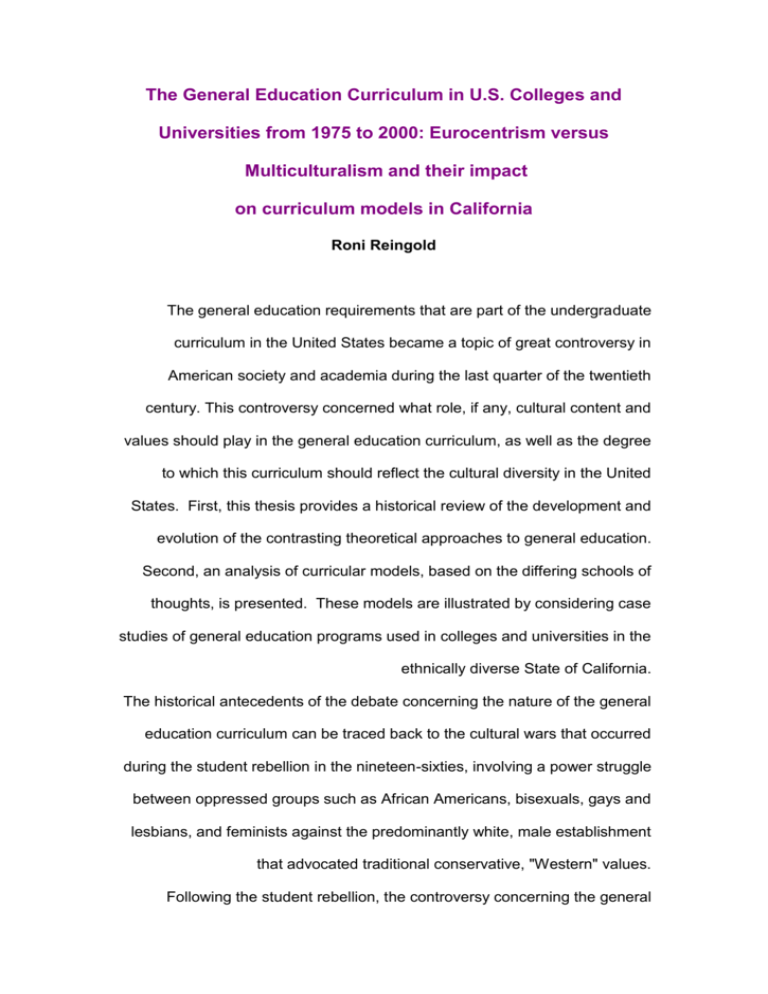
The General Education Curriculum in U.S. Colleges and Universities from 1975 to 2000: Eurocentrism versus Multiculturalism and their impact on curriculum models in California Roni Reingold The general education requirements that are part of the undergraduate curriculum in the United States became a topic of great controversy in American society and academia during the last quarter of the twentieth century. This controversy concerned what role, if any, cultural content and values should play in the general education curriculum, as well as the degree to which this curriculum should reflect the cultural diversity in the United States. First, this thesis provides a historical review of the development and evolution of the contrasting theoretical approaches to general education. Second, an analysis of curricular models, based on the differing schools of thoughts, is presented. These models are illustrated by considering case studies of general education programs used in colleges and universities in the ethnically diverse State of California. The historical antecedents of the debate concerning the nature of the general education curriculum can be traced back to the cultural wars that occurred during the student rebellion in the nineteen-sixties, involving a power struggle between oppressed groups such as African Americans, bisexuals, gays and lesbians, and feminists against the predominantly white, male establishment that advocated traditional conservative, "Western" values. Following the student rebellion, the controversy concerning the general education curriculum received intense scrutiny mainly within academic circles, with the different ideological camps proposing very different programs. Several factors led to this debate gaining national prominence in public discourse and media, and in the political arena. One such factor was the publication of several best sellers during the late nineteen-eighties, the most influential of which of was Allan Bloom's book, The Closing of the American Mind, discussing the role of cultural values in the American society in general, and in academia in particular. A second factor was the intense confrontation at Stanford University in 1988 that resulted in dramatic changes to the general education curriculum. Specifically, a Eurocentric program, named "Western Culture", was replaced with a multicultural program referred to as "Cultures, Ideas & Values" (C.I.V.). The struggle which led to these changes at Stanford was not confined to academic circles. Prominent political figures, such as William Bennett, who was George Bush's education minister at the time, and Jesse Jackson, a leading African American activist and an influential member of the Democratic party, played essential roles in bringing national attention to this confrontation. Finally, in the nineteen-nineties, numerous articles in the popular press, documentaries, television programs, and scientific or pseudo-scientific books and publications that dealt with the Eurocentrism versus Multiculturalism debate were produced. Methodology The present research is based on interpretation and analysis of a wide range of texts including popular publications and media (magazines, books, television, documentaries), academic research, articles in student newspapers, internal memos and position papers, and minutes of committee and senate meetings involving curricular reforms. In addition, of primary importance was the analysis of specific course materials including syllabi, course descriptions and rationales, and reading and viewing lists. Textual analysis was performed based on the border pedagogy approach advocated by postmodernist scholars such as Michel Foucault, and "CriticalPedagogy" scholars such as Henry A. Giroux. One of the important assumptions underlying the present textual analysis was that none of the sources should be regarded as a secondary source because they all reflect the beliefs and positions of the proponents, and as such, are an integral part of the debate itself. In the first part of the thesis, positions and developments are discussed in chronological order. Occasionally, the chronological order is temporarily disrupted in order to provide a comprehensive exposition of a particular scholar or ideological camp. In the second part of the thesis, selected general education programs are presented and analyzed to illustrate specific curricular models. Such models represent examples of concrete manifestations of the more comprehensive theoretical and ideological positions discussed in the first part of the thesis. Given that much of the debate revolves around the issue of multiculturalism, the programs selected as illustrations were taken from universities and colleges in California, which is the most culturally and ethnically diverse state in the United States with large populations of African Americans, Hispanics, Asian Americans, and Native Americans. In addition, California is at the forefront of the struggle of other minorities, such as bisexuals, gays and lesbians and feminists. Findings At the first phase of the struggle over the general education curriculum there were four major schools of thought: The extreme eurocentric approach – this approach argued for a return a) to an exclusive focus on Western cultural content and values. This camp believes that this culture constitutes universal, absolute truths and values. The moderate eurocentric approach – this approach argued for general b) education to be predominantly based on Western cultural content and values, but acknowledged the potential importance of other world or minority cultures. c) The radical multicultural approach – this approach was based on the politics of identity and argued for an exclusive focus on the cultural contributions and products of oppressed minority groups in the United States. d) The ethnocentric non-Western approach – this approach was proposed primarily by afrocentric scholars who argued that any particular oppressed group should exclusively focus on the cultural achievements of members of that minority as a means for developing ethnic pride. They further argue that these achievements were hidden by the Western elite for the purpose of subjugating and controlling minorities. In the nineteen-eighties the moderate eurocentric approach evolved into an approach termed "Multicultural pluralism". The primary tenet of this approach is that the American culture is largely Western in content and values, but that it was influenced by the contributions of non-Western cultures and minority groups within the United States. Accordingly, this approach advocated maintaining focus on Western culture but supplementing general education programs with substantial introduction to non-Western cultures. In the nineteen-nineties multiculturalism became the predominant conceptual framework toward general education. This involved the emergence of several new approaches. One of which was named the "American cultures" approach. According to this approach, all of the different ethnic groups produced substantial cultural contributions throughout the American history, even if some of these contributions went unrecognized due to oppression by the dominant Western elite. This approach was based on the politics of diversity that recognized that all ethnic cultures are essential building blocks in the formation of the American meta-culture. Furthermore, the liberal left advocated additional approaches that called for cultural and social transformation in the United States based on the principles of democracy and social justice. This led to the proposal of curricula based on a combination of multiculturalism and critical pedagogy. The Neo-Marxist non-liberal left advocated another approach based on a combination of multiculturalism and critical pedagogy. In parallel to the development of the different schools of thought, specific models of general education requirements emerged. Some of the early models included a eurocentric curriculum as well as an afrocentric or ethnocentric curriculum, with the former including Western culture courses, and the latter exclusively focusing on a particular ethnic culture. Subsequently, a whole variety of multicultural curricular models were created, including more radical ones which required only non-Western courses (ethnic studies) as well as ones which were based on multicultural pluralism that allowed selecting courses from a variety of Western and non-Western courses. In addition, in the nineteen-nineties, the "Association of American Colleges and Universities" (AAC&U), a voluntary association of colleges and universities to discuss and debate academic and curricular issues, proposed several general education curricular models. In the first half of the nineteennineties it proposed the "American cultures" model and subsequently, a model that combines multiculturalism and critical pedagogy. Implications The controversy surrounding the general education curriculum investigated in this thesis may provide interesting theoretical and practical implications for the growing interest and discussion concerning multiculturalism and multicultural education in Israel. As in any attempt to generalize beyond a particular cultural and sociological context, caution must be exercised. It is clear that Israeli and American societies differ substantially on a multitude of cultural and sociological dimensions. Nevertheless, the author of the thesis, who considers himself a social activist, argues that studying the history of the controversy in the United States may provide a very valuable perspective for Israeli researchers and educators.

